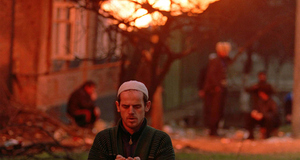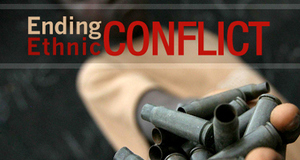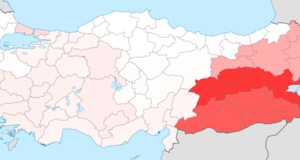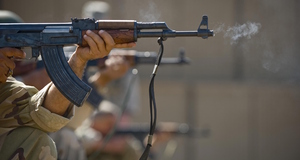Causes of Violent Conflict in the Caucasus Since the Collapse of Communism
By
2013, Vol. 5 No. 01 | pg. 2/2 | « Politics of State DisintegrationWith the collapse of the USSR, the Caucasus faced the breakdown of the Soviet regime and the planned economy. Its successor states were faced with the task of state and nation building as ethnic tensions escalated to unprecedented levels. Without the strong hand of the Soviet government and its structural constraints to keep tensions in check, the new leaders were not able to predict the consequences of their actions and they struggled to consolidate and legitimize state power. Derluguian (2005, pp. 219) states that “the course of events could turn on such small contingencies as timing, personal acquaintance, contemporary social ‘mood,’ or one lucky move.” Political elites competed intensely and some attempted to profit from the breakdown of state power. These ‘violent entrepreneurs’ established ‘unholy’ alliances across class and ideological divides to see economic profit in this chaotic environment (Derluguian 2005). The institutions mediating local problems were no longer in existence, and elite competition was no longer guided by a specific set of rules (Zurcher 2007). Internal divisions within the new governments made formulating and carrying out strategies to maintain the territories a significant challenge. Indeed, in his mission to supposedly rescue Georgian officials in southern Abkhazia, head of the National Guard Tengiz Kitovani marched into the territory but instead went straight to the capital where Georgian soldiers captured local government buildings and looted the city, beginning the Georgian-Abkhaz war. The campaign was seen as the personal initiative of Kitovani, and while justifying the war in Abkhazia, Shevernazde admitted that the unproportional use of force was unnecessary (de Waal, 2010). Small arms were ubiquitous, and paramilitary organizations emerged, such as the Mkhedrioni in Georgia (de Waal, 2010). In Azerbaijan, military leader Surat Husseinov left the region of Kelbajar undefended and abandoned the front line in the conflict with Armenia to wage a coup d’état against the Elchibey government while the Armenians effortlessly captured Kelbajar (de Waal, 2010).Of all the newly independent states that faced secessionist groups, none of them were successful in maintaining the autonomous regions in their territories through the use of force. One can partly explain this fact by examining the organizational capacities of the opposing sides; the officially recognized governments were just as incapable of coordinating military actions as the formerly autonomous regions. Zurcher (2007) has thus posited that the violent conflicts resembled war between two start-up firms than as a war between states and rebels. In this anarchic environment where states lost their monopoly on the means of violence, the threshold preventing violence disintegrated (ibid). State disintegration thus led to the use of force and violent means in order to achieve goals. While state disintegration as such was not the source of conflict, a lack of legitimate and strong state institutions explains why conflict broke out during the relatively short window of time in the early nineties. The Role of RussiaThe extent to which Russia is either an external actor or a party to the conflicts in the Caucasus has been debated widely among academia. While during the first several years after the independence of the Russian Federation, one cannot identify a single uniform policy in the region, there was a group of Russian political elite who sought to shape the conflicts to Russia’s advantage. Several entities that emerged following the Soviet collapse attempted to integrate various peoples in the region. The Confederation of Mountain Peoples in the Caucasus aimed at unifying all of the North Caucasian people along with Abkhazia and South Ossetia, freeing them from Russian and Georgian dominion. Conversely, Gamsakhurdia proposed a ‘Caucasian House’ seeking a similar aim, but his nationalist rhetoric alienated South Ossetia and Abkhazia from joining such a project. Moscow then sought to gain the loyalty of the two territories by ensuring their protection and security as a means to prevent any unified entity from forming in the Caucasus. Russia’s support for the territories is nothing new; such was also the case in the early twentieth century. Protection has also taken the form of military assistance, as Abkhazia acquired landmines and heavy weapons, none of which had existed in the territory previously. In Nagorno-Karabakh, Russia initially had a clear pro-Armenian stance, based on strategic interests and common religious beliefs. Furthermore, a pro-Armenian stance was also visible during the late Soviet period, as several of Gorbachev’s closest advisors were Armenian. When Azerbaijan stated its goal of the removal of Russian military bases and troops from its territory, Armenia, who previously maintained the same goal, swiftly changed its position and allowed the Russian military presence to remain. Moscow used levers such as military assistance and entry to the CIS with Azerbaijan in order to pressure it to comply with Russian strategic interests. However, as Baku sought to capitalize upon its natural resources, the extent to which Russia could instrumentalise the Nagorno-Karabakh diminished. In the all the conflicts, it is thus clear that Moscow sought to destabilize regimes that denied Russia its goal to be the sole security guarantor in the region (Abushov, 2009). ConclusionHaving analyzed the many factors relevant in the outbreak of conflict in the Caucasus, it is evident that some of the factors are more applicable and crucial in certain territories than others. The ethno-federalist structure of the Soviet Union was quite significant in giving a certain ethnicity its own territory and institutions. This experience of self-autonomy thus seems one of the most important factors of all the conflicts in the Caucasus. Demographic conditions and its evolution was helpful in understanding why a particular group may or may not have felt marginalized in a certain territory. Historical grievances and discriminatory policies were quite influential in unifying a mobilising ethnic groups around their identity, as well as escalating tensions between groups. The emergence of ethnic nationalism was significant in antagonizing ethnic groups and radicalizing their elite, increasing the risk of secession. Furthermore, state disintegration removed the threshold for violence and the new successor states were forced to fight in which organizational capacity was minimal. The strategic interests of the Russian Federation to maintain its influence in the region were important for understanding its involvement in the Caucasus. The article has also shown how the complexities of the Caucasus should be seen within the regional framework, rather than comparing the conflicts with those outside the Soviet Union. ReferencesAbushov K, 2009. Policing the Near Abroad: Russian Foreign Policy in the South Caucasus. Australian Journal of International Affairs, 63(2), 187-212. Aphrasidze D & Siroky D, 2010. Frozen Transitions and Unfrozen Conflict, Or What Went Wrong in Georgia? Yale Journal of International Affairs, Vol. 5, No. 2, 121-136. Barrington L, 2006. Introduction: Nationalism & Independence, in “After independence: making and protecting the nation in postcolonial and postcommunist states,” Barrington L (ed.), The University of Michigan Press, Ann Arbor. Bohr, A. 1998 ‘Turkmenistan and the Turkmen’, in The Nationalities Question in the Post-Soviet States, ed. Smith, G., Longman, London. Brubaker R, 1996. Nationalism reframed: nationhood and the national question in the New Europe, Cambridge University Press, Cambridge. Bremmer, I. 1993. ‘Reassessing Soviet Nationalities Theory’, in Nations and Politics in the Soviet Successor States, eds. Bremmer, I. and Taras, R., Cambridge University Press, Cambridge. Bunce V, 2004. “Is ethnofederalism the solution or the problem?” in Nationalism after communism: lessons learned, (eds.) Mungiu A & Krastev I, Central European University Press, Budapest. Cornell S, 2001. Small nations and great powers: a study of ethnopolitical conflict in the Caucasus, Curzon Press, UK. Cornell S, 2002. Autonomy and Conflict: Ethnoterritoriality and Separatism in the South Caucasus – Cases in Georgia, Department of Peace and Conflict Research, Report No. 61, Uppsala. de Waal T, 2010. The Caucasus: an introduction, Oxford University Press, New York. Derluguian G, 2005. Bourdieu’s secret admirer in the Caucasus: a world-system biography, The University of Chicago Press, Chicago. Fowkes B, 2002. Ethnicity and ethnic conflict in the post-communist world, Palgrave, New York. King C, 2008. The ghost of freedom: a history of the Caucasus, Oxford University Press, New York. Lobell S & Mauceri P, 2004. Ethnic conflict and international politics: explaining diffusion and escalation, Palgrave Macmillan, New York. Rezvani B, 2008. “The uniqueness of the Caucasian conflicts?” in “Caucasus Studies: Migration, Society, and Language,” (ed.) Vamling K, Caucasus Studies 4, Malmo University. Toft M, 2006. The geography of ethnic violence: identity, interests, and the indivisibility of territory, Princeton University Press, Princeton & Oxford. Zaslavsky V, 1992. Nationalism and democratic transition in postcommunist societies, Daedalus, Vol. 121, No. 2, 97-121. Zurcher C, 2007. The post-Soviet wars: rebellion, ethnic conflict, and nationhood in the Caucasus, New York University Press, New York & London. Endnotes1.) When there is one-to-one correspondence between ethnicity and territory, the dominant ethnicity is referred to as the ‘titular’ group, while all others within a certain republic as ‘non-titular’ 2.) Abkhazia was originally given SSR status in 1921, but in 1931 was downgraded to an ASSR 3.) (i.e., Kyrgyz-Uzbek conflict in Osh, Russian-Moldovan conflict in Transdniestria) 4.) Notably, the Armenians, which at one point even outnumbered the Abkhaz 5.) Conversely, Abkhazia and Adjara were allowed to maintain their autonomous status, but eventually war broke out in the former, while the latter was able to avoid large-scale violence 6.) Such was the case for Abkhazia, Chechnya, Nagorno-Karabakh, and South Ossetia 7.) An individual who has moved to an urban area without transition to an urban lifestyle; their primary occupation does not provide the basis of household income and thus he or she must seek odd-jobs, engage in the informal economy, or become a migrant laborer, making their lifestyle unstable and particularly vulnerable in situations of conflict (Derluguian 2005) Suggested Reading from Inquiries Journal
Inquiries Journal provides undergraduate and graduate students around the world a platform for the wide dissemination of academic work over a range of core disciplines. Representing the work of students from hundreds of institutions around the globe, Inquiries Journal's large database of academic articles is completely free. Learn more | Blog | Submit Latest in International Affairs |


















